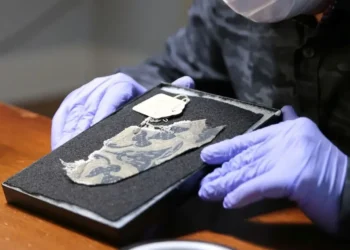Long-Hidden Archaeopteryx Fossil Stuns Scientists with New Clues About the First Bird’s Flight
A rare and nearly complete Archaeopteryx fossil—kept hidden in a private collection for over three decades—has finally been unveiled to the scientific world, and the findings are nothing short of groundbreaking.
Recently acquired by the Field Museum in Chicago, this spectacular specimen of the earliest known bird is helping scientists better understand how flight evolved in dinosaurs. And for researchers who’ve waited years for access, the results have been “one wow after another.”
Fossil Reveals Flight-Ready Feathers
The 150-million-year-old fossil, about the size of a pigeon, is one of only 14 known Archaeopteryx specimens. But unlike others, it’s remarkably well preserved in 3D and contains fossilized soft tissues rarely seen in similar finds.
Using ultraviolet light and CT scans, paleontologists uncovered flight feathers known as tertials, which are critical for powered flight in birds. These feathers grow near the elbow and body and had only been hypothesized in Archaeopteryx—until now.
“This is the first concrete evidence that Archaeopteryx had the feather structure necessary for active flight,” said Dr. Jingmai O’Connor, lead author of the study and associate curator at the Field Museum.
More Than Just Feathers
The fossil didn’t stop at feathers. Researchers also discovered details in the toe pads that suggest the creature foraged on the ground—similar to modern birds like pigeons. And bones in the roof of its mouth offered clues about cranial kinesis, the ability of birds to move parts of their skulls independently, enhancing beak flexibility.
“It’s just revelation after revelation,” said O’Connor. “The preservation is unlike anything we’ve seen.”
A Long-Awaited Breakthrough
The fossil had been privately held since 1990, inaccessible to scientists. The Field Museum took a chance on acquiring it in 2022, not knowing its condition. What they got turned out to be a once-in-a-generation discovery.
“This might be the most significant fossil acquisition since SUE the T. rex,” said museum president Julian Siggers.
Field Museum fossil experts spent over 1,600 hours meticulously preparing the specimen—scanning, cleaning, and reconstructing it in 3D to unlock its secrets.
Could Archaeopteryx Actually Fly?
Dr. Susan Chapman, a bird evolution expert at Clemson University, praised the find. “This specimen gives us unprecedented insight into the transition from dinosaurs to modern birds,” she said. However, she noted that while Archaeopteryx could likely fly, it wasn’t built for long-distance travel. It lacked modern flight adaptations like a strong keel bone for anchoring powerful flight muscles.
Even so, the presence of tertials makes it clear: this early bird wasn’t just gliding—it was flapping.
A Lesson in Access
Beyond the science, the fossil also reignites a broader conversation about fossil access. “When fossils are locked away in private collections, vital data is lost—sometimes forever,” Chapman said. “This discovery shows just how important open scientific access is.”
O’Connor agrees. And with more analysis still underway, she believes this fossil has even more stories to tell.
“We’re just getting started,” she said. “There’s so much more to discover—and I hope everyone finds it as thrilling as we do.”
This article was rewritten by JournosNews.com based on verified reporting from trusted sources. The content has been independently reviewed, fact-checked, and edited for accuracy, neutrality, tone, and global readability in accordance with Google News and AdSense standards.
All opinions, quotes, or statements from contributors, experts, or sourced organizations do not necessarily reflect the views of JournosNews.com. JournosNews.com maintains full editorial independence from any external funders, sponsors, or organizations.
Stay informed with JournosNews.com — your trusted source for verified global reporting and in-depth analysis. Follow us on Google News, BlueSky, and X for real-time updates.














